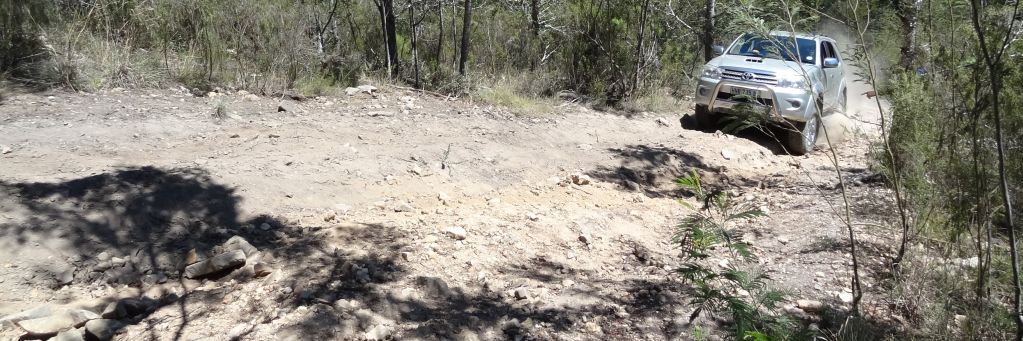 After his adventure in the mud pool, Bud could hardly wait to get back into the training area and this article finds him back at the clubhouse the following week. The Instructor had promised to show him how hill climbs work, but they first had to get some weight onto Bud’s 4WD. To this end, the Instructor told Bud to first stop at the sand pit where there are some 200 kg sand bags, of which he wanted two on the 4×4 to help with traction on the loose, gravelly surface of the mountain tracks.
After his adventure in the mud pool, Bud could hardly wait to get back into the training area and this article finds him back at the clubhouse the following week. The Instructor had promised to show him how hill climbs work, but they first had to get some weight onto Bud’s 4WD. To this end, the Instructor told Bud to first stop at the sand pit where there are some 200 kg sand bags, of which he wanted two on the 4×4 to help with traction on the loose, gravelly surface of the mountain tracks.
Sand bags loaded and securely strapped down, the Instructor guided Bud along some two-wheel tracks toward the steep-ish mountainside on which they were going to be going up and down.
“OK, Bud, today we will be going straight up and down a mountain track, which is why we need the weight; you could do it without the weight, of course, but the extra weight helps a bit with traction, of which you need as much as you can get on the track we will be doing because it is overgrown with grass in places and covered in sand patches in others. The other track has a loose, gravel surface and while the weight here does not help traction very much, it makes the 4×4 heavier coming down, which will give you a better idea of how well your hill descent control system actually works. It also helps to demonstrate the effectiveness of your hill start assist system. However, we will not be doing the other track today because by doing both you might not get the benefit of seeing the same one attacked from both sides, since the contrast in driving technique will be lost.”
“Of course, electronic driving aids work without added weight but experience has shown that inexperienced off-road drivers learn to trust these systems quicker if they first experience them with heavy, loaded vehicles. When you go on your first off-road trip through Southern Africa, or maybe deeper into Africa, you will more likely be carrying at least double the load you are now, so the sooner you learn to trust your 4×4 and its electronic driving aids, the better you will be able to cope with problems on your own later on.”
During the 20-minute trip to the mountain over a variety of farm roads, rutted tracks, small mud puddles and sand patches, Bud became somewhat more aware of the power of his 4×4; it merely chugged along at 30 km/h, unaffected by the 400 kg on its load bed.
“Right, Bud, here we are, but switch off the engine for a bit- I want to show you something you should avoid at all costs:
Side slopes
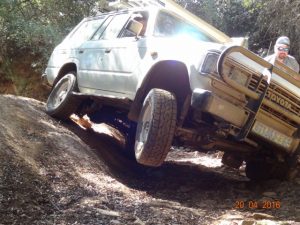 Bud joined the Instructor on the passenger side of the 4×4. They were on a slight incline before the mountain track proper and the Instructor was pointing at some tyre tracks that turned off the main track and continued across the face of the incline at right angles, until they disappeared from sight around a curve in the mountainside.
Bud joined the Instructor on the passenger side of the 4×4. They were on a slight incline before the mountain track proper and the Instructor was pointing at some tyre tracks that turned off the main track and continued across the face of the incline at right angles, until they disappeared from sight around a curve in the mountainside.
“This is what is called a “side slope”, but I will not be teaching you how to negotiate them because we might end up the same way as the chap that left these tracks: you have a rollover mitigation system on this 4×4 do you? Good. Rollover warning and mitigation systems may be good things to have but you should never place yourself in a position where you need them. This slope for instance, has a 23 deg. angle on average: some 4WD vehicles can fall over at around 35 deg, but some at more and others less, which means that you have at most only a few degrees to play with before you can expect to roll over. However, there are many variables involved here, such as tyre pressure, height of the centre of gravity, loads carried inside and/or on roof racks, as well as the evenness and surface of the side slope. Some people try to see how far they can take it before falling over but this is a stupid thing to do, especially if you are deep into Africa where there is usually no one to help you should you roll over.”
“It might be necessary to go across the side of a hill, which may not be such a big problem if the terrain is even, but if you hit a bump on the uphill side or a dip on the downhill side, the sudden weight transfer might flip you over. Since the rollover angle is calculated by drawing a line between the lowest, or supporting wheel, and the centre of gravity, which is different for all 4×4 vehicles, you should never attempt side slopes until you are sure you know what the rollover angle is on your particular 4×4.”
“The centre of gravity on any vehicle is a point at which all the mass of the vehicle is concentrated and if you picked it up at that point the vehicle will be perfectly balanced. However, the problem is that this point is calculated for an empty 4×4, with no canopy, roof rack, spare wheels on brackets, jerry cans of fuel and water, and whatnot. So, if someone tells you that the centre of gravity on your 4×4 will give you a rollover angle of say, 40o, you might find that if you add all the stuff expedition 4WD vehicles usually have, which makes you top heavy, you might end up with a roll over angle of only 30o or very much less, and even more so if you are driving on under-inflated tyres. Under-inflated tyres can fold in under the rims on the low side, with the result that the sudden weight transfer if this happened, could again let you roll over.”
“You can’t see the wreck from here, but the chap that rolled over just beyond the bend in the mountain, had a fatal roll over at only 25o. He was part of a group that was planning an expedition to the Great Lakes region in Africa and he came here with his 4×4 fully loaded and equipped for this expedition just to see what sort of side slopes he could negotiate with his fully loaded 4×4. According to the people who saw it happen, they told him to at least remove the eight jerry cans of water and two spare wheels from the roof rack but he would not because as he put it, “” he would not then get a reliable result to his experiment””. Well, the result he did get killed him because he did not wear a seat belt, which would have prevented him falling out of his seat and breaking his neck against the passenger side window when he rolled over, despite the curtain airbags.”
“The wreck is still there; his mates only took away his equipment and all the rest he was carrying and now they come here once a year to put flowers inside the wreck. I can’t imagine why though: to my mind they would have done a far better thing by stopping him from doing his foolish “experiment”, and taking him along to see the flowers around Lake Malawi for himself, instead of bringing them here where he can’t see them- since he is dead.”
“But as I said before, going across a side slope can be done safely and you might even have to, but only if there is no alternative. Of course, dessert sand dunes are something else altogether; you just never do it if the angle is more than about 15o or so, and then only if and when there is no alternative. On sand dunes you have no traction at all and if the sand suddenly gives way, or shifts under you, you are almost guaranteed to roll over, so, don’t do it.”
“Incidentally, we do not have sand dunes here so I cannot show you how it works, but the only way to get down a sand dune is by using engine braking, which acts as a braking force, but without actually using the brakes. This allows the front wheels to rotate, which is something you need to happen to be able to maintain directional control but even so, sand dunes are sometimes so steep and almost liquid that even using engine braking can cause the entire dune face to come sliding down, almost like an avalanche. Some off-road drivers use the hand brake to lock the rear wheels which then act as anchors to create a supposedly stabilising drag, but this could cause the back end to start sliding which is impossible to control on a sand dune, and almost invariably leads to a roll over.”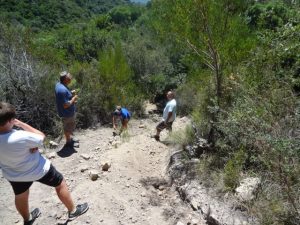
“But the bad news is that you cannot use engine braking on an automatic transmission to get down steep hill sides, whether they are sand dunes or otherwise, because the torque converter cannot be locked: it cannot provide the solid mechanical link between the wheels and the engine that a clutch can. In fact, by using engine braking on an automatic, you only let the transmission fluid overheat, sometimes past boiling point, which is the surest way to destroy an automatic transmission. All the different gums and varnishes that form when transmission fluid overheats, effectively weld the various clutches and control mechanisms inside the transmission together, which more often than not turns an automatic transmission into scrap metal. But back to our business at hand, which is getting up and down hills with reasonably solid surfaces.”
“Now, this hill is not as easy as it looks Bud; from this point it is about 370 meters long and as you can see, the gradient varies quite a bit. From 23o we are, it increases to around 28o just before that hump about three quarters of the way up, with the hump itself being 430, before it decreases again to 300 all the way to the top. You will also notice that the only part of the track that is solid is the hump itself. It is too steep for sand or gravel to stick to it, but the rest as you can see, alternates between grass, sand, and gravel, which are all difficult surfaces in themselves and almost impossible for 4×4’s without some form of electronic driving aids to cope with without running into trouble.”
“OK, so because you have all sorts of electronic driving aids, you might be tempted to try different things to get to the top, which is flat by the way, but the thing with hills is that you mostly only get one chance to get to the top, because despite all the bells and whistles, getting started again if you lost momentum and stalled could be difficult, if not impossible. For one, the brakes might not hold you on a steep incline with a loose surface but even if they did, brakes usually do not work as well in reverse as they do moving forward.
Secondly, starting on a hill, especially if you have a ton of weight on the back, could cause you to burn out the clutch, or just as bad, start the wheels spinning, which translates into a complete loss of traction, which could cause you to roll backwards off the edge despite all the power you think you have. It is an easy mistake to make but once your wheels start spinning, you might be tempted to apply even more power to counter the backward roll, but this will only increase the wheel spin, which is not a good thing when you are on a steep hill.”
In the third place, stalling on a hill could cause you to roll back down because of the difficulty and time it takes to restart, select a lower gear, and maybe engage 4WD mode, which is what you should have done before starting climbing the hill in the first place. Once you start rolling back with a ton of weight on the back it is almost impossible to stop- you are guaranteed to lose control and even if there was not an edge to fall down from, you are almost certain to roll over once you start going downhill diagonally.”
“But none of that is going happen today: you have all of the driver assist systems required to help you get to the top and back down again, so, for this hill you need to select low range first gear to get you over the 43o hump, and traction control to eliminate wheel spin on the slippery parts. You also need the hill start assist to prevent stalling when you take off, as well as the anti-stall system to prevent stalling if your speed drops off after you have started moving. You have seen traction control in conjunction with low range in action and you know what these systems do, but we have not tried out the hill start assist.”
Hill Start Assist
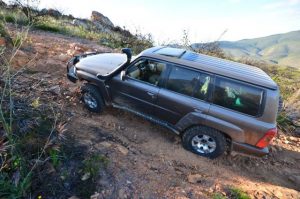 “So, have you used the hill start assist on your SUV? No? OK, well, it works because of a sensor that senses when the vehicle is on an incline, together with the wheel speed sensors of the ABS to confirm that the wheels are not rotating. If the system is satisfied that the vehicle is stationary on an incline, it will apply the brakes to hold it still for an indefinite period if the driver does nothing. However, when the driver wants to move off, sensors on the pedals will alert the system that the driver wants to move but it will hold the brakes until the torque develops to the point where it overcomes the braking force.”
“So, have you used the hill start assist on your SUV? No? OK, well, it works because of a sensor that senses when the vehicle is on an incline, together with the wheel speed sensors of the ABS to confirm that the wheels are not rotating. If the system is satisfied that the vehicle is stationary on an incline, it will apply the brakes to hold it still for an indefinite period if the driver does nothing. However, when the driver wants to move off, sensors on the pedals will alert the system that the driver wants to move but it will hold the brakes until the torque develops to the point where it overcomes the braking force.”
“The initial braking force is kind of like ABS in reverse. The driver does not have to touch the brake pedal for the system to work, but using the wheel speed sensors to detect any sign of reverse rotation of the wheels; the system will apply just enough braking force to hold the vehicle stationary, irrespective of its weight or the angle of the incline. In practice this means that once the system detects movement on the clutch and accelerator pedals, it gets ready to progressively release the brakes as soon as the wheel speed sensors detect forward rotation of the wheels.”
“This eliminates any tendency to roll back, and the traction control will in its turn eliminate wheel spin. However, all sorts of things could happen: the surface might be so slippery that all four wheels could start spinning, which will confuse the traction control system, or the driver might inadvertently forget not to engage the front diff lock. Front diff locks that are in operation prevent a driver from steering around obstacles, of which there could be any number on the way to the top. Therefore, if you are going to climb a hill with twists and turns, or if you cannot see clearly that there are no obstacles all the way to the top, get out and walk the obstacle. No matter how tough it is, walk all the way to the top to see for yourself there are no dangerous hidden rocks, holes, or other hindrances that you need to steer around, or could destroy your momentum, or your 4×4.”
“So, Bud, on this hill we will not use the diff locks because we need to go around two corners on the way. However, we could use the rear diff lock if we need to, but only for as long as we have to, because I want you to get a feel for the way the 4×4 handles when there is real power involved. The traction control could cause some sideways slipping and sliding in the ruts and I want you to experience that because it can be a little unnerving. The success of your off-road excursion through Africa might depend on you getting all the way up a hill, so the sooner you get used to the sometimes weird handling traction control can cause, the better.”
Anti-stall
 “You are only carrying 400 kilograms in added weight, which should not be a problem since you are using the traction control, the hill start assist, as well as the anti stall systems in low range first gear, which should be enough to get you up Table Mountain, in a manner of speaking. But this is a nice opportunity for you to try out the anti-stall feature you have: it only works in low range and on some 4×4’s it works in low range reverse as well, but it works by assuming control of the throttle when it senses that the engine is about to stall. The only way to stop it working is by turning it off, because no amount of brake pressure will slow you down while it is working, which is both good and bad. Bad because if you don’t switch it off quickly enough, you could hit an obstacle you wanted to avoid, and good because it relieves you of the need to worry about throttle control.”
“You are only carrying 400 kilograms in added weight, which should not be a problem since you are using the traction control, the hill start assist, as well as the anti stall systems in low range first gear, which should be enough to get you up Table Mountain, in a manner of speaking. But this is a nice opportunity for you to try out the anti-stall feature you have: it only works in low range and on some 4×4’s it works in low range reverse as well, but it works by assuming control of the throttle when it senses that the engine is about to stall. The only way to stop it working is by turning it off, because no amount of brake pressure will slow you down while it is working, which is both good and bad. Bad because if you don’t switch it off quickly enough, you could hit an obstacle you wanted to avoid, and good because it relieves you of the need to worry about throttle control.”
“So, if you are clear on all this and as soon as you are ready, select and turn on everything you need and let’s see if you can beat this hill, but get your revs up to 2500 first, so you don’t have turbo lag to deal with when you need torque.”
Bud did as he was told but to see if the Hill Start Assist system really worked, he let go of the brakes and to his amazement, the heavy 4WD did not roll back. He fully expected at least some roll back but he stood still, as if rooted to the ground, and satisfied that it really worked he let out the clutch.
Again to his amazement, his (to his mind, overloaded) 4×4 moved off without so much as a moment’s hesitation or any jerkiness: there was just sudden, albeit slow, movement, and resolving to not let the engine stall, he kept his eye on the rev counter, keeping above 2500 revs. Then just as he hit 4 km/h, the Instructor told him to let go of the accelerator to make sure the anti-stall system worked. It did, and deciding to trust it for the moment, he concentrated on the track leading up the mountain.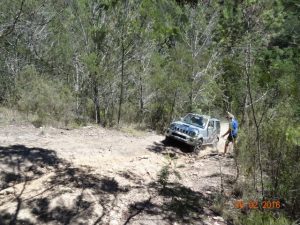
He did not notice any strange or quirky handling issues but put it down to the fact that he was too inexperienced to know what was strange and what was not. The only thing that was noticeable was the fact that no matter what he went over, sand, grass, or gravel, there was no sign of wheel spin. At times, he thought the steering was a little jerky, but the 4×4 followed the track flawlessly, without the need for any sort of corrective action, but the 430 hump was approaching and the Instructor told him to resume throttle control by putting some pressure on the accelerator pedal before deactivating the anti-stall system.
“OK, Bud, you need to have full control over the throttle for this hump, because the anti-stall system is not intuitive: all it does is to prevent the engine from stalling but it cannot compensate for sudden changes in the gradient of a hill. Although at these revs you have more than 90% of maximum torque already, anything can happen and you need to be able to get the last few percent of torque immediately if you should need them, and the electronics cannot do that for you.”
Bud did as instructed and he attacked the hump at 2700 rpm, which he was still at when he reached the plateau and got ready to face the last 50 metres to the top of the mountain. The only thing he noticed while negotiating the hump was a slight change in the exhaust note, almost as if the engine was working a little harder than before, but more amazed than ever at the brute power of the 4×4, he reached the top of the mountain, which as the instructor told him, was flat.
“Nicely done Bud, but stop under that tree for a minute, but do not switch the engine off: the turbo is now spinning at more than 200 000 rpm, and it needs time to slow down, so just keep the engine at idle. We will be going down that same hill in a minute but before we do, I have to ask if you noticed anything strange about how the 4×4 handled. Were you at any point nervous, or did you at any point think you were not going to make it to the top? No? Well, I think we should have deflated the tyres a bit; it always helps on sand and I did notice the traction control had a rough time keeping the wheels from spinning a few times, but we made it, so no harm done. We will be experimenting with tyre pressures in the sand pit in the following few weeks, but for now, we have to get down the mountain. So, are you ready?”
Bud had a few concerns about how he was going to control his speed going down and he asked some questions about it, for instance, how was he going to prevent the wheels from locking up since he had seen for himself that the ABS system is less than effective on loose slippery surfaces.
Hill Descent Control
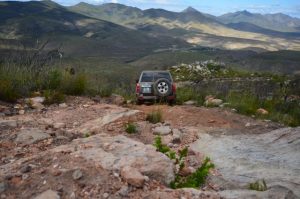 “That is a very good question Bud, and I am glad you mentioned it because it is very important that you understand the issues involved in going down steep hills, where it is very easy to lose traction and therefore control.”
“That is a very good question Bud, and I am glad you mentioned it because it is very important that you understand the issues involved in going down steep hills, where it is very easy to lose traction and therefore control.”
“We will be using high range first gear in 4WD mode, because we need the engine braking force this will give us. We cannot rely on the brakes alone; the hill is too steep and too long for that. Using just the brakes will let them overheat on the one hand and it might lead to either dangerous levels of brake fade in the later stages of the descent, or wheel lock-ups in the early stages, on the other hand. Both these conditions are potentially fatal, so we need a way to prevent either, or both, from happening.”
“As I said before, engine braking is a way to generate a braking force without using the brakes, but by using low range, you could have too much of it as well. Low range is great for going uphill but the opposite effect is achieved going downhill. It becomes very difficult for the wheels to rotate against the reversed gear ratios, the wheels now driving the larger gears against the smaller ones in the transmission, and in particular against the reversed ratio in the low range gear set in the transfer case. In practice, because the wheels are so difficult to rotate, the reversed ratios can cause all the wheels to lock-up, or rather, fail to rotate on loose surfaces, exactly the same as applying too much braking force via the brake system.”
“To help minimise this problem, you use high range to allow the wheels to rotate easier, while still maintaining a significant braking force. This allows a greater braking force to be applied via the brake system, which gives you a greater measure of control over the speed you want to maintain. However, since the ABS system will not be working, you have to find another way to stop the wheels from locking up, so you use the Hill Descent Control system. This is again like the ABS in reverse: an ABS system allows the wheels to rotate freely until they lock up through the application of too much braking force, when it will release the brakes on the affected wheels until all the wheels rotate at the same speed.”
“In contrast to this, a HDC system uses the wheel speed sensors, the traction control system and some elements of the cruise control system to maintain a braking force on individual wheels until they lock up, when it will release the pressure until it rotates again but at the speed set via the cruise control system. This system will always maintain a braking force on the wheels but at differing pressures, depending on the surface. For instance, if the wheels on one side are on tar, and the other on the gravel shoulder, the system will maintain braking force to both sides but at the pressures required to allow both sides to rotate at the same speed. Since there is less traction on the gravel side, the pressure on that side will be reduced to prevent lock-ups, but on the tar side, the pressure will be increased until the wheel sensors detect a lock-up, when it will reduce pressure to those wheels only, until they match the speed at which the gravel-side wheels rotate.”
“The system can switch pressures to individual wheels several dozen times per second, so while the system is in operation, the driver does not even have to touch the brake pedal. Because once the speed is set, the system will maintain that speed until it senses that the vehicle is not going downhill anymore, or of course, until it is deactivated.”
“As all of this pertains to this particular hill, the high range will allow the wheels to rotate but under the braking force generated by running the ratios in reverse, which while it does not preclude the possibility of wheel lock-ups, significantly reduces the chances of it happening. We could of course not use engine braking at all, but this will place the entire load on the brakes alone, which could destroy the brakes through overheating because of the length of the hill and the time and pressures needed to get down it. Thus, by lessening the load on the brakes by using engine braking, the chances of the brakes overheating are significantly reduced.”
Bud had no idea his 4WD could do all the stuff the Instructor was telling him about. He knew about the cruise control of course, but he would never have thought that it could be used to control the brakes while going down steep hills. His head was spinning with all the technical stuff, but by now, he had full confidence in his Instructor; if he said something was going to happen in a certain way, it always did, and there was no reason why it was going to be different going down the mountain track.
“OK Bud, so if you are ready, we can try this and see what happens. However, remember, the hill descent control system is based on the cruise control so while we are moving down hill, do not use either the brakes or the accelerator because that will deactivate the system. We do not want that- you will not be able to maintain control if this happens and you are unlikely to get the 4×4 down to a speed at which the HDC system will be able to control the vehicle safely. Just let it do its own thing; set the speed at 10 km/h and let the electronics do the work; all you have to do is concentrate on steering. Now, the system will not work until it senses the vehicle is on a decline, so just get the front wheels over the edge and turn it on, but be sure to check that the indicator light on the dashboard confirms the system is turned on. You do not want to start moving down hill thinking the system is in operation when it is not.”
Hill Descent Control in Action
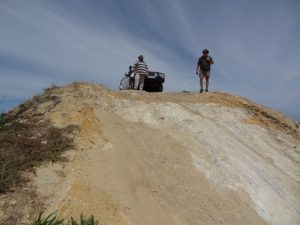 “Once we start moving, check the speedometer; set the speed at 10 km/h; once the speed is set, do not touch the pedals, and enjoy the ride- the system will maintain the speed you set and you can just steer. Got all that? Good, let’s see what happens.”
“Once we start moving, check the speedometer; set the speed at 10 km/h; once the speed is set, do not touch the pedals, and enjoy the ride- the system will maintain the speed you set and you can just steer. Got all that? Good, let’s see what happens.”
Bud’s confidence in the Instructor’s knowledge and experience was once again fully justified. Although he had the distinct impression that the 4×4 did not need him anymore, he nevertheless marvelled at the way the speedometer remained rock steady at the 10 km/h mark at which he had set the system, especially on the downhill side of the 430 hump, where he fully expected to notice an increase in braking force but he was disappointed; the system adapted to the change in gradient seamlessly- he did not notice a thing.
Although Bud thought the steering felt a bit heavier and commented on it, the Instructor said this was merely because of the weight transfer to the front axle as well as the constant braking force on the front wheels. Nevertheless, apart from this, never once did Bud get the impression that the expensive electronic driving aids on his 4WD were not up to the task of getting him to the bottom of the mountain in one piece.
Nor did Bud get the impression that the traction control was struggling with anything: he was not aware of any slipping or sliding, and as far as he was concerned, he got his money’s worth in all the electronic driving aids he had installed. Again he had the feeling that all of Africa was stretched out in front of him, his mighty 4×4 conquering all obstacles in its way. However, sadly, just as he was victoriously driving down the far side of Kilimanjaro, the Instructor reminded him that they had reached the bottom and he should deactivate the HDC system by tapping sharply on the brake pedal. For now, his African adventure was over, at least as far as the hill climb and descent in the club training area was concerned. However, Bud will be back.
Hill Climbs in Africa
“Nicely done Bud, and I am beginning to notice that you have more confidence in your 4×4, which is important because South Africa, in fact Southern Africa and the rest of Africa is full of mountain passes and hill climbs. Nevertheless, do not forget this was only an exercise in the basics of hill climbs and hill descents; you were never in any real danger but the reality of the off-road driving conditions in Africa is somewhat different.”
“There is no room for mistakes when doing hill climbs when you are on an off-road expedition in the hinterland of Africa: if you should happen to choose the wrong gear, or worse, use the wrong off-road tyres, you are on your own when you get stuck or fall off a cliff. There is no one to help you, or even tell what to do before you start a hill climb. Mistakes are usually serious and more often than not lead to injuries or even fatalities.”
“You saw what could happen on a side slope, so you want to be extra careful of those, and never take a chance when being careful is the safer option. Also, do not be afraid not go down a steep hill, even with a Hill Descent Control system: if your gut tells you that it might be dangerous or too much for your skill set, it probably is. Off-road driving in Africa is not about seeing who gets there first; it is about getting there in one piece with an undamaged 4×4, but I think told you that already, so be safe, be careful, and enjoy the ride.
“Next week we will be doing a water crossing and everything that goes with that. So, if you don’t mind, you can just drop me at the club house on your way home, and I will see you next week.”
